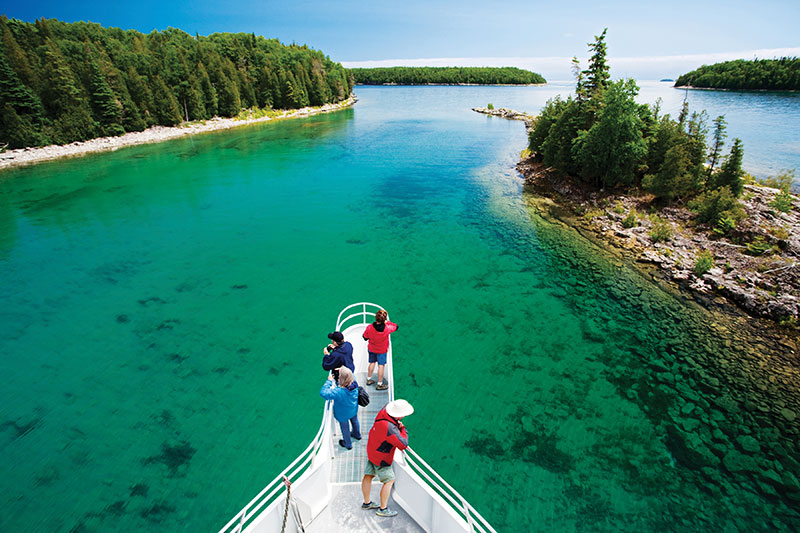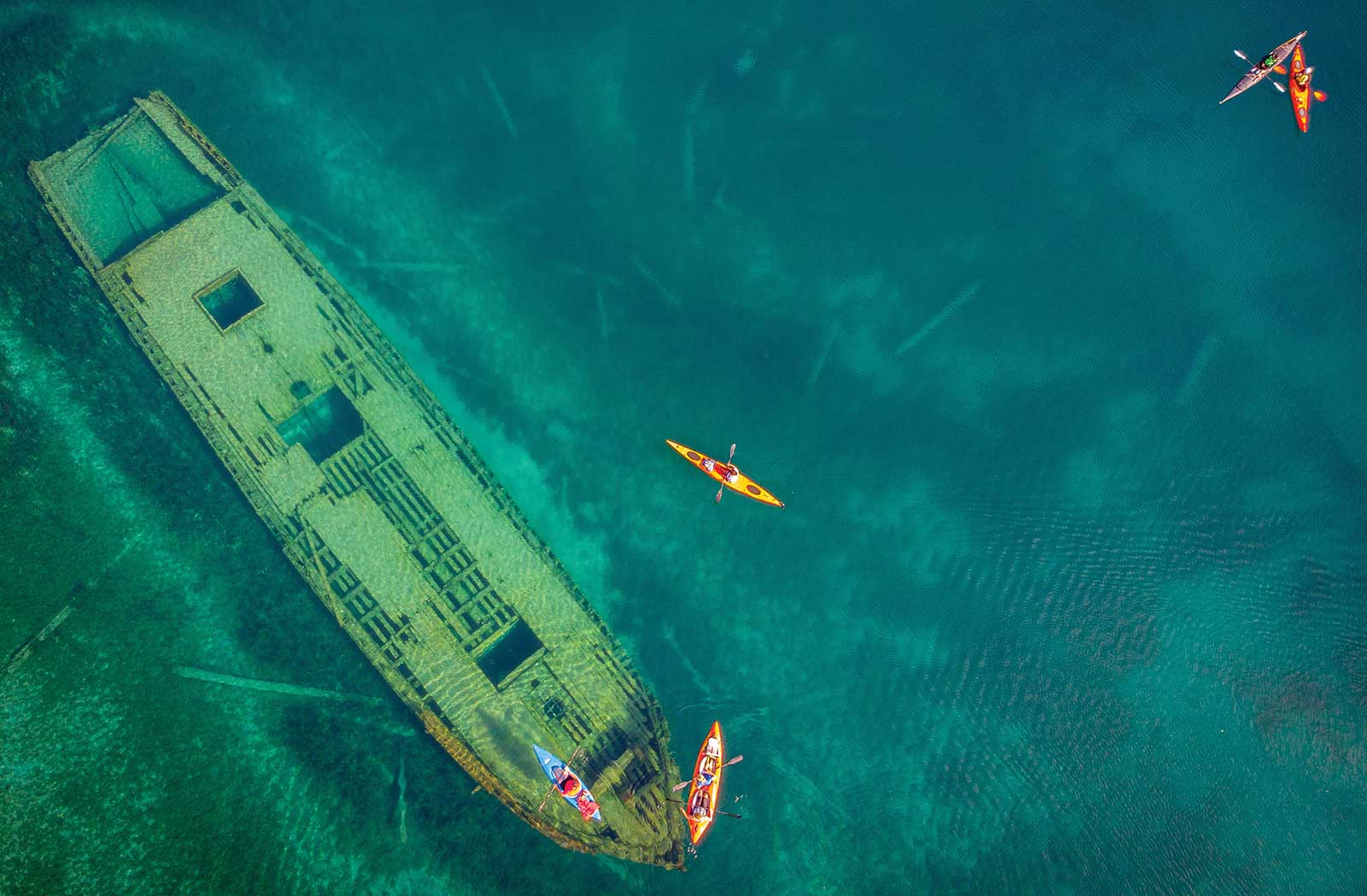
Perched at the tip of Ontario’s Bruce Peninsula, Tobermory might signal the end of the road for motorists, but for boaters, it’s where the land ends and the whole world begins.
As a little kid growing up in southern Ontario, it was hard to not feel an affinity for the beautiful village of Tobermory, jutting into Lake Huron at the tip of the Bruce Peninsula.
This was the end of the road — literally — the place where the cars either turned around or gave up the pavement for a spot on the giant Chi-Cheemaun car ferry that would take them the rest of the way to Manitoulin Island.
As befitting the end of the road, Tobermory was a wild place, its bare granite outcrops, weathered pines and Group of Seven natural beauty representing a sharp contrast to the manicured parks and lawns back home in Toronto, nearly four hours to the south. And there were the old shipwrecks, some even visible from shore! But more than anything else, it was the sense of being surrounded by water on three sides that gave Tobermory its incredible mystique. With the open waters of Lake Huron to the west, Georgian Bay to the east and Manitoulin Island hidden somewhere over the horizon as you looked toward the north, to my adolescent mind this wasn’t so much the end of the road as the beginning of the world.
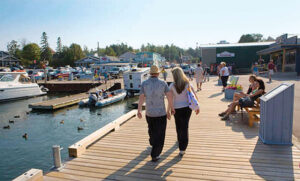 It still feels that way today.
It still feels that way today.
From its snug perch overlooking Lake Huron’s gin-clear waters, Tobermory is a pretty community of about 4,000 full-time residents — a figure that swells to three times that number in the summer when the seasonal cottagers arrive. For residents and visitors alike, life centers around Tobermory’s two outstanding natural harbors. The village sits on a small peninsula of its own, sandwiched between the Big Tub Harbour to the north and the Little Tub Harbour to the south. Little Tub is the more commercial of the two, being now more or less surrounded by the present-day village.
Where many Great Lakes settlements can trace their roots back hundreds of years, Tobermory is a relative newcomer. Native peoples and early commercial fishermen had put up shacks along its protected shores for years, with the fishermen even erecting a lighthouse to mark the tip of land at the entry to the Big Tub. But the site’s remote location and rocky terrain kept Tobermory off the grid and accessible only by boat until 1869. That’s when land surveyor Charles Rankin arrived, charged with mapping a roadway through the rock and brush to connect Tobermory with Owen Sound, some 60 miles to the south.
Following several weeks of “the most troubling explorations I have ever met with” Rankin completed his task, and the first groups of settlers began to arrive in Tobermory a year or two later. Many of these early pioneers found the granite landscape too difficult to work and simply gave up, abandoning their farms. That hasn’t changed, and the Bruce Peninsula remains sparsely populated to this day with most residents either working in the local tourism industry or commuting to jobs in Owen Sound, Southampton or other communities to the south along Rankin’s Road — today better known as Highway 6.
For visiting boaters, however, the wild landscapes and crystal clear waters are the main attractions, providing a rare opportunity to enjoy the northern lakes in their pristine, untouched beauty.
Easy navigation
Situated on the end of a peninsula that juts some 60 miles into the lake, Tobermory is easy enough to find, whether you arrive by car (keep driving north until your feet get wet) or by boat (land ho!). Its position at the northern tip of the Bruce Peninsula once earned Tobermory the unfortunate moniker of Shipwreck Capital of the Great Lakes due to its exposure to almost any winds, relatively few lighthouses and numerous unmarked islands and shoals. Thankfully, modern weather forecasting and charting make navigating the area a piece of cake today.
Approaching from Lake Huron, the best route into Tobermory is to pick up the Devil Island Channel at Cape Hurd, a little over three miles from town, and simply follow its well-buoyed path. If you’re arriving from Manitoulin Island, the North Channel or from Georgian Bay to the east, navigate south of Flowerpot Island to avoid its many shoals before heading straight into town. A newer, red-topped white lighthouse marks the mouth of Big Tub Harbour, with additional buoys leading southeast to Little Tub. Regardless of which route you follow, you’ll want to keep an eye out for the 365-foot, 7,000-ton car ferry MS Chi-Cheemaun (Ojibwe for “big canoe”) as you approach the town. The terminal sits on the shore between the Big and Little Tub Harbours, and the big boat always has the right-of-way.
Most of Tobermory’s main attractions are most conveniently accessed from Little Tub Harbour, so point your bow there. That’s also where you’ll find the town docks, the fuel dock and the pump-out dock. Municipal guest slips line the harbor’s southern side opposite the ferry terminal, with space for about 50 transient boats; call ahead on VHF 68 or head to the well-marked fuel dock for a slip assignment.
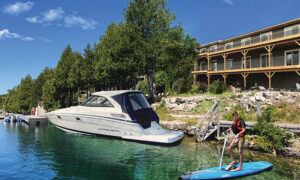 While it’s not quite as convenient to the town’s amenities, mooring in Big Tub Harbour can be a lot quieter and a more peaceful option, particularly on busy summer weekends. Big Tub Harbour Resort, located on the north side of the harbor, has space for about 20 transient boats; call ahead on VHF 68 to secure a spot.
While it’s not quite as convenient to the town’s amenities, mooring in Big Tub Harbour can be a lot quieter and a more peaceful option, particularly on busy summer weekends. Big Tub Harbour Resort, located on the north side of the harbor, has space for about 20 transient boats; call ahead on VHF 68 to secure a spot.
Let’s get acquainted
Once you’ve tied up and settled in, you’ll probably want to look around a bit and stretch those legs after a day or two on the boat.
The horseshoe-shaped village surrounds Little Tub Harbour, making it easy to navigate and a pleasant stroll at any time of day. As you wander, you’ll notice a series of historic plaques here and there, which provide fascinating details on significant sites related to the town’s fishing, lumbering and shipping heritage.
On the southeast side of Little Tub Harbour you’ll spot a curious-looking cairn, which marks the northern terminus of the Bruce Trail, one of Canada’s most popular hiking routes. Established in the 1960s, the Bruce Trail meanders south and east along the Niagara Escarpment, passing through pristine Carolinian forest and open farmlands for more than 550 miles before reaching its southern terminus at the Niagara River near Buffalo, New York. If you’re looking to stretch your legs, and we mean really stretch your legs, Tobermory has you covered.
For a nice wander that stays a lot closer to the boat, take a toddle up Bay Street, which follows the southeast side of Little Tub Harbour. There you’ll find a range of restaurants, pubs, shops, an art gallery and basic provisions, including a grocery and a liquor store.
Explore the Bruce and Resort website
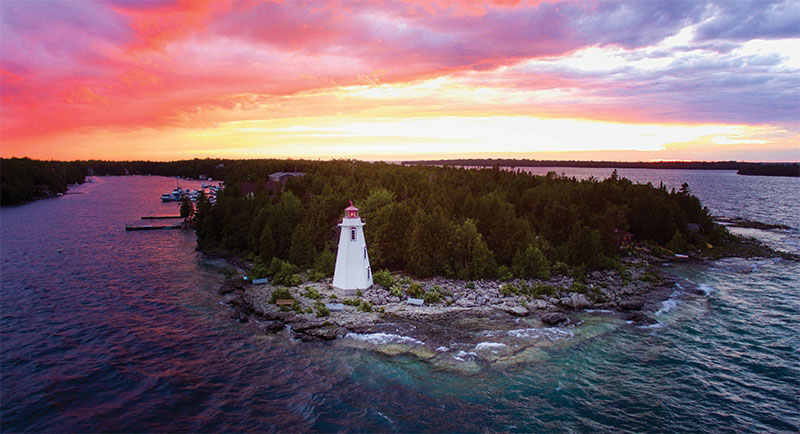
Adobe Stock
Ontario Tourism
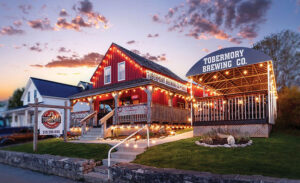 For a small village, Tobermory is served by an impressive range of places to eat, ranging from brew pubs to breakfast spots to bakeries to full sit-down restaurants. Fish and chips featuring locally caught whitefish is a staple that’s available everywhere and universally delicious. Craigie’s Harbourview Restaurant, the Crowsnest Pub and Grille, and Shipwreck Lee’s are popular favorites, while the Tobermory Brewing Co. serves up tasty fare with a revolving menu of craft beers. Prefer Mexican fare? Then make your way to Tacomory (pun very much intended) for great Mexican grub, food truck style. There’s also the Little Tub Bakery — just follow the irresistible aroma of fresh bread and you’ll spot it soon enough.
For a small village, Tobermory is served by an impressive range of places to eat, ranging from brew pubs to breakfast spots to bakeries to full sit-down restaurants. Fish and chips featuring locally caught whitefish is a staple that’s available everywhere and universally delicious. Craigie’s Harbourview Restaurant, the Crowsnest Pub and Grille, and Shipwreck Lee’s are popular favorites, while the Tobermory Brewing Co. serves up tasty fare with a revolving menu of craft beers. Prefer Mexican fare? Then make your way to Tacomory (pun very much intended) for great Mexican grub, food truck style. There’s also the Little Tub Bakery — just follow the irresistible aroma of fresh bread and you’ll spot it soon enough.
After you’ve snarfed down some whitefish why not follow with a tasty desert? Beavertails is a Tobermory institution that’s well known for its remarkable fried dough pastries shaped like, well, a beaver’s tail. Or opt for ice cream at Ice Cream and Treats. Either way, you can’t go wrong. Tobermory may not be a particularly large village, but rest assured you’re not going home hungry.
Wandering the town reveals an enticing array of shops to browse, including the Hummingbird House, Golden Gallery, Georgian Bay Soapworks and the Net Shed for gifts and décor items, along with the Mariner Chart Shop for anything nautical. Pop into Reader’s Haven to pick up a few books for the boat, or check out Verna’s and the Blue Heron for clothing and nick-nacks.
Nearby, Diver’s Den is the bustling hub serving the scuba and snorkel set, who come from all around the world each summer to visit Tobermory’s wrecks.
See and do
With its unusually clear waters, unique underwater geological formations and more than two dozen shipwrecks within sight of town, Tobermory is globally recognized as a diver’s paradise. But you don’t even have to leave town to see shipwrecks, as a few are even visible from shore. Glass-bottom boats depart from Little Tub Harbour daily offering tours of the local area including multiple shallow water wrecks, allowing passengers to enjoy a close-up view of some of the most interesting ships without ever getting their feet wet.
Or, rent a kayak or stand-up paddleboard to explore at your own pace. Tobermory Cruise Line rents both kayaks and SUPs for visitors who prefer to chart their own course — and get some good upper body exercise — while enjoying the local area.
One of the most popular wrecks lies at the extreme western end of Big Tub Harbour. The Sweepstakes, a 19th-century, 120-foot coal schooner, came to rest on the bottom of the harbor in 1885 after running aground on a reef near Cove Island. Freed and towed to Big Tub Harbour for repairs, the vessel continued taking on water as the owners and insurance companies argued over the repair costs. The ship ultimately sank and, given the added salvage costs, was subsequently written off. Today, the Sweepstakes is visible in barely 20 feet of water, making it a favorite of swimmers, snorkelers and scuba divers alike.
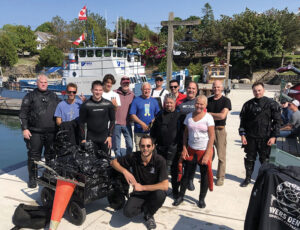 Forgot your swim fins? The Diver’s Den offers two-hour guided snorkel trips with all gear supplied. Apart from the Sweepstakes, the Diver’s Den also leads guided snorkel trips to other nearby wrecks, including the Charles P. Minch with its visible steering wheel in 20 feet of water, and the W. L. Wetmore with its intact boiler, propeller, anchor and chains.
Forgot your swim fins? The Diver’s Den offers two-hour guided snorkel trips with all gear supplied. Apart from the Sweepstakes, the Diver’s Den also leads guided snorkel trips to other nearby wrecks, including the Charles P. Minch with its visible steering wheel in 20 feet of water, and the W. L. Wetmore with its intact boiler, propeller, anchor and chains.
Just off the bow of Sweepstakes, you’ll find yet another popular Tobermory wreck. The City of Grand Rapids is super easy to spot, since at normal water levels a good chunk of it still pokes above the surface. The double-decked package steamer ran a regular route to Manitoulin Island for years, until catching fire at the dock in Tobermory one evening in 1907. A tug dragged the burning vessel into open water and cut it loose, only to have the prevailing wind push it back into port, where it drifted the length of Big Tub Harbour until bottoming out next to the Sweepstakes. It burned to the waterline and its lower hull remains there today.
To truly appreciate Tobermory’s underwater history, make a point of visiting Fathom Five National Marine Park, located a short walk east of Little Tub Harbour. Established in 1987, Fathom Five is the first national marine park in Canada, with most of it located under the lake’s surface. Created to protect shipwrecks and conserve freshwater ecosystems, the park includes 20 islands that provide critical habitat for a wide range of plants and animals, including the monarch butterfly, the eastern ribbon snake, the eastern whip-poor-will, and several rare ferns and orchids.
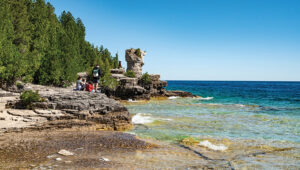 One of the islands, Flowerpot Island, is noted for its namesake flowerpot stacks of sedimentary rock that stand a short distance from the island itself.
One of the islands, Flowerpot Island, is noted for its namesake flowerpot stacks of sedimentary rock that stand a short distance from the island itself.
Most Great Lakes ports of call would consider themselves very lucky to have a prominent national park situated nearby. Tobermory has two of them.
A short distance farther south and abutting Fathom Five, Bruce Peninsula National Park overlooks Georgian Bay in dramatic fashion, with sheer cliffs and distinctive landmarks attracting visitors with cameras from all over the map. One of the largest protected areas in southern Ontario, Bruce Peninsula National Park forms the core of UNESCO’s Niagara Escarpment World Biosphere Reserve. Multiple hiking trails provide a great opportunity to stretch those legs after a long boat ride.
Two of the most popular spots in Bruce Peninsula National Park are The Grotto — a water-level cave that extends deep into the limestone cliff — and Indian Head Cove, a delightful inlet with a clean limestone bottom yielding bright turquoise waters that look a lot more South Pacific than Great Lakes. It’s a stunning sight, even on a cloudy day.
Not far from the park entrance is the St. Edmunds and Peninsula Museum, which offers an interesting look back at Tobermory’s early days. The site includes a restored 1875 log cabin, a 19th-century schoolhouse and a range of artifacts that provide detailed insight into the daily lives of early settlers in the region and the difficulties of survival in a remote and comparatively inaccessible environment.
Relaxing back at the boat after a long day of exploring, it’s easy to appreciate today’s comforts and conveniences, including the wonders of modern nav charts and weather forecasting. And that’s exactly why Tobermory ranks so high as a port of call on every Great Lakes mariner’s bucket list. With its extensive maritime heritage, stunning natural beauty and thoroughly modern amenities for visiting boaters, there really is something here for everyone. After all, it’s where the road ends and the whole world begins.
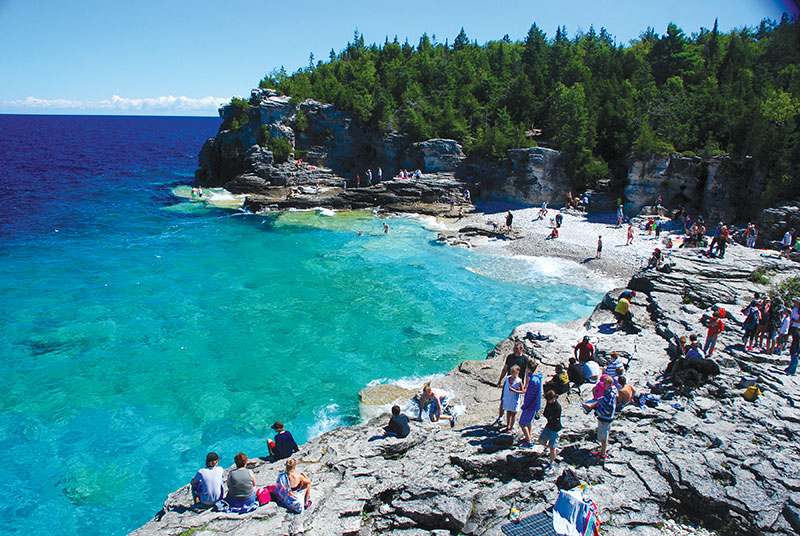
Josh Delp
Meet The Big Canoe
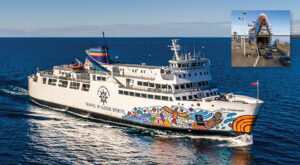 The car and passenger ferry Chi-Cheemaun runs a regular route linking Tobermory and South Baymouth on Manitoulin Island from mid-May to mid-October. It’s also the third-largest passenger ship sailing the Great Lakes, after the expedition cruise liner Viking Octantis and SS Badger.
The car and passenger ferry Chi-Cheemaun runs a regular route linking Tobermory and South Baymouth on Manitoulin Island from mid-May to mid-October. It’s also the third-largest passenger ship sailing the Great Lakes, after the expedition cruise liner Viking Octantis and SS Badger.
A trip to Manitoulin aboard Chi-Cheemaun is a long-standing Great Lakes tradition. Built in 1974, the vessel has a capacity of 648 passengers and 143 vehicles, including room for buses and transport trucks. Chi-Cheemaun makes the 25-mile trip to South Baymouth in a little under two hours, crossing three times each day during peak season, and twice a day during May, June, September and October. For schedules, fares and details call 519-376-8740 or visit ontarioferries.com/ms-chi-cheemaun.
Marine Facilities
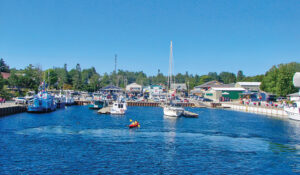 Little Tub Harbour
Little Tub Harbour519-596-2731, 519-375-6033, or VHF 68
explorethebruce.com/place/tobermory-harbour-marina
519-596-2219, or VHF 68
bigtubresort.ca
Big Tub Harbour is a little farther from the town’s shops and restaurants, but it’s also a bit quieter and more secluded. Transient slips with or without power are available.


